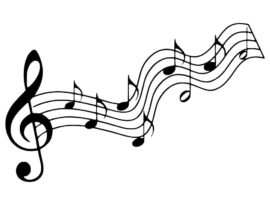Interviews with composers almost always begin with the question: "What inspired you to write this song?" Why is inspiration so intimately connected with music and song? What is special about a song that makes it more than just an alternative to speech as a way to express oneself?
This week’s Torah portion, Beshalach, features the Az Yashir, The Song at the Sea. After having witnessed the great miracles of the plagues and the demise of the Egyptians, the Jews burst into song, praising G-d for all that He had done for them. Why did the Jews sing their praise to G-d, why couldn’t they have merely spoken their feelings? Would it not have accomplished the same goal of praising G-d for the miracles? At a basic level, the reason why the Jews burst into song upon being rid of their enemy was that they were in a good mood. But there was something a lot deeper that caused the Jews to sing.
Biblical Hebrew is a fascinating language. It is the very language that G-d Himself composed and used to create the world. Created by G-d, it contains a deep wisdom incomparable to any language in the world. Therefore when a word has more than one definition, it begs the question: When G-d created this language couldn’t He in His infinite imagination have come up with another word to mean this? He couldn’t have been running out of words! Rather, one must assume that if G-d did give more than one meaning to a single word, it must be that there is a common denominator among these definitions.
.
One such example is the Biblical Hebrew word, ta’am. It can be defined as taste or reason, as well as a third meaning. The word used for the cantillations, the tune used for reading the Torah, is also called ta’am. What can be the common theme among these three concepts that share the same word yet seem so diverse?
The link among these three seemingly diverse concepts is “essence”. By looking at a piece of food it is difficult to really tell what its component ingredients are, but a taste can help reveal it’s essence. Similarly, seeing someone do a seemingly unexplainable act presents a mystery. Once the person’s motivations are discovered, the reason for that act is revealed and we can reach a greater understanding. The cantillations of the Torah reveal the essence of the Torah on two levels. At a complex level, the cantillations contain deep secrets of the Torah, and only elite scholars are privy to these profound concepts. On a simpler level, the cantillations tell us where to put the “commas” in the text of the Torah, as well as where a sentence begins and ends. The words alone don't necessarily tell us what the Torah is trying to teach us. But when formed into sentence structures, we can begin to understand the inner workings, the essence of the Torah’s teachings.
The above description of the cantillations, the song of the Torah, sum up the underlying concept of song. As the classic commentaries put it, “Song is the language of the soul”. Unlike the power of speech, which comes from the intellect, the power of song comes from one’s deepest emotions, ones essence. There are occasions when a person becomes so inspired that the only way to fully express that feeling is through song. Therefore when the Jews saw the miracles at the sea, they were so uplifted to new levels of belief in G-d that they burst out in song, the language of their souls.
The ta’am, whether in the context of the essence of food, the essence of reason, or the song that emanates from the essence of the soul, is a manifestation of deeper understanding and spiritual awareness. The mode of expression may differ, but the depth of feeling is a common theme in music. The Jewish soul calls out to G-d through music, and a song that is sung with sincere emotion and the right focus can truly raise a person to greater spiritual heights.

